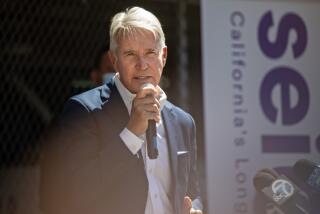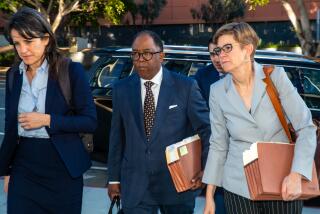D.A.’s Office Distorted Evidence, Pancer Argues
- Share via
Charging that the district attorney’s office “resorted to smear tactics and character assassination . . . to distort the picture” of Mayor Roger Hedgecock’s 1983 campaign, defense attorney Michael Pancer argued on Tuesday that there “is not one iota of evidence to suggest” that Hedgecock broke the law in his personal or campaign finances.
In a four-hour, seven-minute summation that concluded the defense’s case in the mayor’s felony conspiracy and perjury trial, Pancer argued that prosecutors “ignored some pieces of evidence and distorted others” in an attempt to “paint a picture that (conformed) . . . to their crazy preconceived conspiracy theory.”
“They knew the facts . . . weren’t on their side,” Pancer said, thrusting his fist at jurors to emphasize his point. “They can’t stand the truth in this case, because the evidence shows that Mr. Hedgecock is innocent of each and every one of these charges.”
After Pancer’s closing arguments, Assistant Dist. Atty. Richard D. Huffman, who will have the chance to speak to the jury last because the prosecution carries the burden of proof, briefly began his rebuttal late Tuesday afternoon. After Huffman presents his rebuttal, Superior Court Judge William L. Todd Jr. will read a lengthy list of instructions concerning legal points and evidence to the six-man, six-woman jury, which will begin its deliberations either late today or early Thursday.
Prosecutors have charged Hedgecock with conspiring with former J. David & Co. principals Nancy Hoover and J. David (Jerry) Dominelli in a scheme to funnel tens of thousands of dollars in allegedly illegal contributions to Hedgecock’s 1983 campaign via a political consulting firm owned by Tom Shepard, a close friend of the mayor. The perjury charges Hedgecock faces allege that he intentionally falsified financial disclosure statements to conceal that and other allegedly illegal financial aid from Hoover and Dominelli.
The defense, however, has characterized the more than $360,000 that the two former J. David officials invested in Tom Shepard & Associates as a routine business investment designed primarily to help Shepard start his business, not to get Hedgecock elected mayor. Hedgecock has conceded that there were errors and omissions on his personal and campaign financial reports, but he describes those mistakes as inadvertent ones caused by his “good-faith effort” to comply with complex regulations.
The burden that confronted Pancer on Tuesday was not only to rebut the myriad allegations that Huffman directed at Hedgecock during his closing statement on Monday, but also to try to put up a protective shield against any final arguments Huffman might make today that Pancer will be unable to respond to before jurors begin pondering their verdict.
Pancer, in fact, drew loud laughter from both jurors and spectators at the trial when he referred to the problem posed by Huffman’s right to have the final word in the case.
“I’ve tried, but I don’t know everything he’s going to tell you,” Pancer said. “So when he stands up to argue again to make some point, (and) you think that I would have had something to say back to it, I would very much appreciate it if you’d try to think of a response that I might have made.”
During his closing arguments, Pancer used about 40 large placards placed on an easel near the jurors’ box to summarize the defense’s interpretation of the charges facing Hedgecock and of the key evidence in the case.
One of the placards listed the 13 conspiracy and perjury counts Hedgecock faces. At several points in his remarks, Pancer, claiming that certain charges had been disproved, approached the placards and dramatically drew a large red X through various allegations.
“They have not shown a conspiracy in this case,” Pancer said at one such moment as he drew an X through the conspiracy charge. “If they have not shown a conspiracy, then you cannot convict somebody of perjury for failing to report the conspiracy,” he added, drawing another X through some of the perjury charges.
Speaking in a soft voice that he occasionally raised to drive home a point, Pancer also gestured frequently to the jurors during his summation, particularly when discussing prosecution evidence that he characterized as “an affront to . . . common sense.”
Pancer consistently directed his most acerbic rhetoric at prosecution charges and evidence, which he denounced as “incredible distortions,” “exaggerations,” “outrageous . . . falsehoods” and “unseemly attempts . . . to smear” the mayor.
Hedgecock, who was seated next to Huffman throughout most of Tuesday’s session, generally maintained a solemn expression, although he occasionally tilted his head toward the jurors during some of his attorney’s most passionate arguments.
“This thing is going to be in the hands of the jury, and that’s where it belongs,” Hedgecock said outside the courtroom. “You’ve got to be nervous, and I certainly am. There’s a lot at stake.” Indeed, a guilty verdict could result in Hedgecock’s being ousted from office, depending on the specific count or counts on which he might be convicted.
One of Pancer’s major goals Tuesday was to attack the credibility of a key prosecution witness, investment counselor Harvey Schuster, whom Pancer called “a liar . . . who provides the only support” for the prosecution’s case.
Last month, Schuster testified that Hedgecock had told him in November, 1981, that he knew that Dominelli planned to invest heavily in Shepard’s firm so that it could run Hedgecock’s mayoral campaign--an allegation that directly conflicts with the mayor’s oft-stated denial of any knowledge of Dominelli’s involvement with the political consulting firm.
Pancer, however, argued Tuesday that Schuster’s “story is not just incredible, it is impossible,” pointing to testimony from several defense witnesses who said that Hoover and Dominelli were still seriously contemplating buying a North County magazine for Shepard to run in December, 1981 --after the time that Schuster maintains that Hedgecock told him about the consulting firm. It was not until after the plans to buy Seacoast magazine fell through that Hoover agreed to finance a consulting firm for her close friend Shepard, Pancer said.
Reiterating a point he first made when he cross-examined Schuster, Pancer argued that the investment counselor lied because he was angry about not having been awarded a lucrative contract to develop the county’s bayfront parking lots in 1982, when Hedgecock was a county supervisor.
In his rebuttal, Huffman responded angrily to Pancer’s suggestion that prosecutors had “created a witness . . . to come here and lie.”
“If you believe that, ladies and gentlemen, you take this case and you throw it right out the front door of this courtroom, because it belongs in the trash can with me,” Huffman said. “It’s been said that the district attorney’s office has resorted to smear tactics, to trial by press. In a pig’s eye we are!”
The heart of the prosecution’s case is Huffman’s contention that one of the major factors in Hoover’s decision to finance Shepard’s firm was her desire to help Hedgecock become mayor. Pancer, though, sought to refute that argument by pointing out that Hoover and Dominelli invested $189,000 of the $361,500 they pumped into Shepard’s firm before and after Hedgecock’s 1983 mayoral campaign.
“How is that for the benefit of the Roger Hedgecock campaign?” Pancer asked.
Pancer also emphasized that when Shepard’s firm was founded in January, 1982, the prospect of any mayoral race before 1984 hinged on then-Mayor Pete Wilson’s fate in the 1982 U.S. Senate race. In early 1982, however, Hoover contributed $1,900 to then-Gov. Edmund G. Brown Jr., Wilson’s November opponent.
“If Brown wins, there is no race for mayor because Pete Wilson stays mayor,” Pancer said. “So is Nancy Hoover trying to help Roger Hedgecock run for mayor when she gave Brown (money)? No, she was trying to help Jerry Brown. She was trying to keep Pete Wilson here in San Diego.”
Similarly, Pancer dismissed as “utterly and absolutely preposterous” Huffman’s contention that a $130,000 oral-agreement loan that Hedgecock received from Hoover actually was intended as a gift. Because Hedgecock used the loan to renovate his South Mission Hills house, his “most public asset,” Pancer called Huffman’s argument that Hedgecock intended to conceal the fact that he received the money and to never repay it “absolutely absurd.”
In fact, the Hoover loan was reported on Hedgecock’s financial disclosure statements, although prosecutors allege that some of the money actually came from the J. David company and argue that the mayor received more than $130,000.
Pancer, however, described the prosecution’s argument as “another attempt to distort the facts in this case.”
“If (Hedgecock) was willing to report and did report the $130,000 home loan from Nancy Hoover, how can they tell you he was afraid to report a $16,000 sale of a note to Nancy Hoover?” Pancer asked.
As he concluded his remarks, Pancer asked the jurors to “kind of step back and get out of the trees of this case and look at the forest.”
“Get an overall look at this case,” he said. “When people see the same picture, the same facts, they just see different things, and that tells you about the people looking at them.
“The district attorney’s office looked at the picture . . . with their bias, with their preconceived notion, their preconceived desires, and they read it a certain way. And from then on they . . . ignored every fact that tended to disagree with their preconceived theory. I ask you not to distort that picture. I ask you to look at the picture fairly.”
More to Read
Sign up for Essential California
The most important California stories and recommendations in your inbox every morning.
You may occasionally receive promotional content from the Los Angeles Times.













